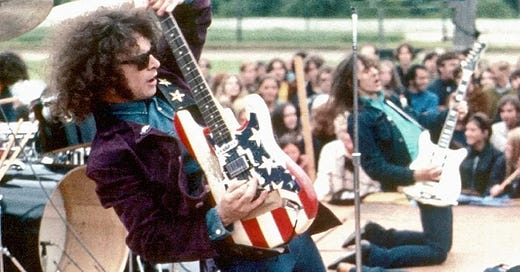Brother Wayne Kramer Has Rambled On To The Next Dimension
The iconic MC5 guitarist died on Groundhog Day 2024 at age 75.

In 1974, my parents, long supportive of my love of music, one day surprised me with a compilation album that had been advertised on TV quite heavily at the time. TV compilation albums were quite ubiquitous at the time - KTel and Ronco advertised the shit out of their pop-oriented compilations, the former especially notorious for cramming 20 songs onto two sides of vinyl by editing the songs they licensed enough to fit onto one side of vinyl, and pressing their records on a grade of vinyl a few micrograms above RCA’s infamous Dynaflex pressings. The album in question was different - it was a double album, the songs were evenly split amongst two pieces of vinyl, and instead of being issued by a company known for “inventions” like the Pocket Fisherman and the Vegomatic, or for a well-meaning device called the Record Selector, it was issued by a major record company. And it wasn’t a compilation dominated by a bunch of recent pop hits, mostly by one-hit wonders.
The album my parents surprised me with (and I cannot recall whether they picked it up in a department store or ordered it through the mail). was called Heavy Metal: 24 Electrifying Performances, released not by the likes of KTel but by Warner Special Products - a dimension of the Warner/Elektra/Atlantic conglomerate. Now, mind you, back around this time, heavy metal was at least six to eight years away from being the style that would be associated with Slayer, Metallica, and their many contemporaries (and, as Jello Biafra would half-seriously joke, “ten thousand bands that sound exactly like Slayer”) and was just part of a lyric in Steppenwolf’s “Born To Be Wild” at the time. But the album helped plant many a seed in your humble author’s then-seven-year-old grey matter. How could it not when on the first record alone, you had songs by Black Sabbath, Alice Cooper, Jimi Hendrix, Deep Purple, T. Rex, and Led Zeppelin?

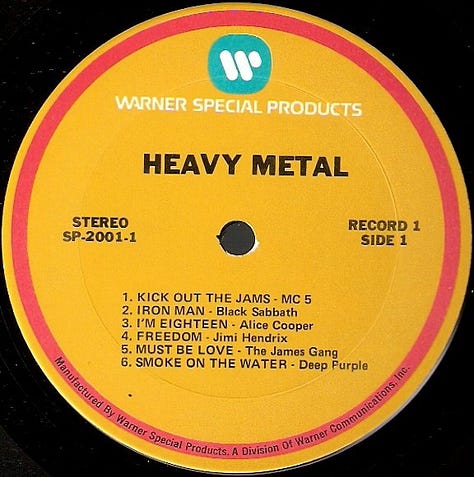
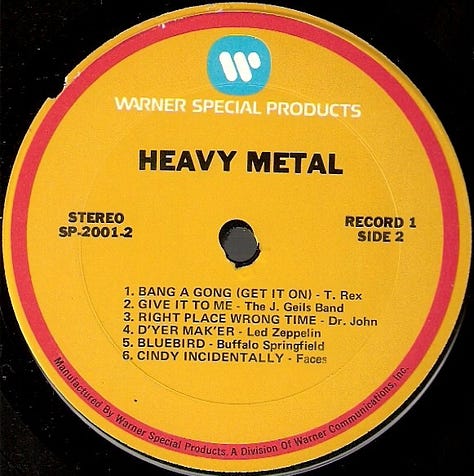
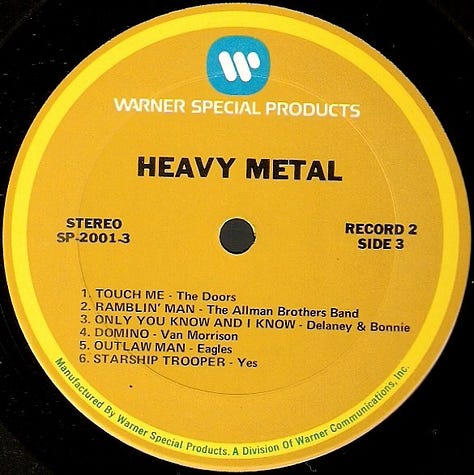

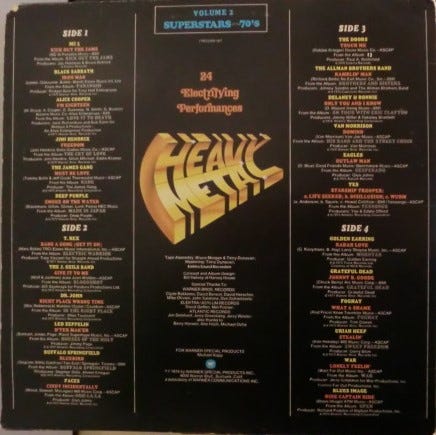
The album wasn’t all what would be retroactively be called hard rock or heavy metal. The likes of The J. Geils Band’s “Give It To Me”, Buffalo Springfield’s “Bluebird”, The Allman Brothers Band’s “Ramblin’ Man”, Van Morrison’s “Domino”, Yes’ “Starship Trooper” (the live version from Yessongs), the Grateful Dead’s version of “Johnny B. Goode” from Skullfuck, and War’s “Lonely Feelin’” were on there, too. Except for the War cut and the inclusion of Golden Earring’s “Radar Love”, everything on the album was connected at the time with the Warner/Elektra/Atlantic family of labels. (One day I’ll have to write about this very compilation for this Substack.)
It was the opening cut on side one of record one that was the first strike of the seed drill in my impressionable young mind. A seemingly disembodied voice yelling “KICK OUT THE JAMS, BROTHERS AND SISTERS!!!” before two crashing powerchords started to tell you just what time it was.
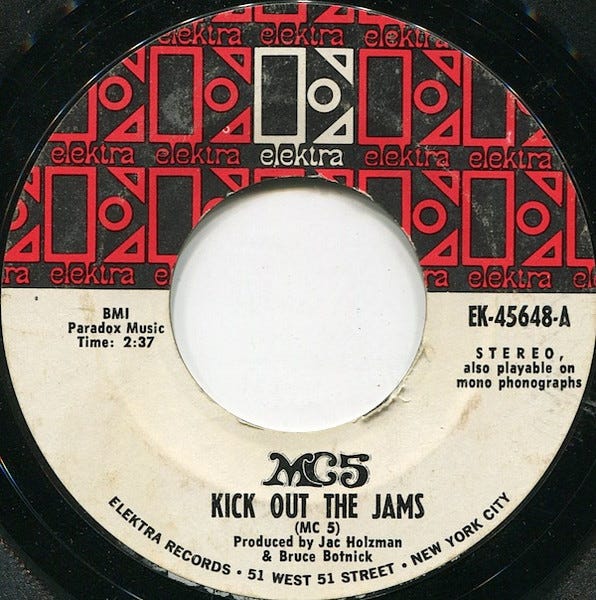
Yep, the opening track on this somewhat random compilation was the single version of the title track of the first album by the MC5, a couple of years after they had unceremoniously broken up after three albums, the first for Elektra and the last two for Atlantic. Someone at Warner Special Products knew better than to have the uncensored version with a favorite term of endearment used by the likes of Miles Davis, Richard Pryor, and Samuel L. Jackson kicking off the damn record - especially since there was still a fresh memory in WEA Land of the band buying advertising in a local underground magazine (and using their label’s name and logo without prior knowledge) with the statement: "KICK OUT THE JAMS, MOTHERFUCKER! and kick in the door if the store won’t sell you the album on Elektra. FUCK HUDSON’S!”
But that’s how a young CJ Marsicano, whose musical diet was already the Beatles (together and apart), tons of now-classic soul hits, Elton John, the Guess Who, Carole King, the Monkees, and Todd Rundgren, amongst others, first heard the MC5, along with most of the other bands on that compilation album.
I mention all of this in this seemingly lengthy introduction because I came out of my day job (which is actually at night for now) to find out that while I was at work and having a good day, I was now living in a world without Brother Wayne Kramer.
FUCK.
I’m long sick of death. From all of the heroes that I lost between December 2015 and January 2017 alone - Lemmy, Scott Weiland, Bowie, Alan Vega, Muhammad Ali, Leonard Cohen - and the dark period of late 2021 to late 2022 where I lost both of my parents, my mother-in-law, the uncle who I loved like an older brother, two former bandmates, my last two living aunts on my mother’s side of the family, and the most painful and completely unexpected loss of all to me, my friend and birthday twin Shannon “Daffney” Spruill - I’m fucking numb to it. All I can do is two things - yell a loud “FUCK!!!” (or at least imagine yelling it), and then try to think good thoughts about the newly lost.
That’s where the rest of this post comes in. Join me now in a video rock wake for Brother Wayne Kramer. Many a band could be considered an early gateway drug to punk rock. Where, in my own case, Cheap Trick could be a surreptitious can of beer and seeing Fear on Saturday Night Live could be that first joint, the MC5 were that cigarette snuck out of your dad’s pack of Newports and lit with a stolen pack of matches. [Also in my own case, the drug parallels are pretty hysterical for this straight-edge person considering I have never smoked tobacco or marijuana in my life.]
Let’s start with Wayne’s time in the MC5 itself. Here’s some famous black-and-white footage of the band, somewhere between the end of their Elektra tenure and moving on to Atlantic Records, plowing through “Ramblin’ Rose”, “Kick Out The Jams”, and “Looking At You” at an open-air performance in their native Detroit. As some of you who have the Kick Out The Jams album in your collection may or may not know, the album’s performance (after a lengthy introduction by the band’s “spiritual advisor” Brother J.C. Crawford) begins not with Rob Tyner on lead vocals but Brother Wayne Kramer himself and his soulful falsetto vocal on “Ramblin’ Rose”.
Dig on Brother Wayne’s moves as he does James Brown-inspired one-foot shuffles in his Beatle boots while peeling off Chuck Berry licks on his Ampeg Dan Armstrong guitar a million times better than his contemporary, Ted Nugent, ever could.
Here’s another of the band’s most widespread tracks from their Atlantic period, “High School” off of Back In The U.S.A. - which rock cinemaphiles will recognize as the song Riff Randall (P.J. Soles) cues up on the turntable when the student body takes over the fictional Vince Lombardi High School in Rock And Roll High School.
By the early ‘80’s, Elektra had quietly put Kick Out Of Jams back into print (without the gatefold featuring the iconic picture of the band shirtless with White Panther Party buttons taped to their chests and John Sinclair’s liner notes that end with the legendary phrase that Rob Tyner utters on the album) thanks to the early mentions of the MC5 as an influence or progenitor of punk rock. GG Allin had realized this early on and managed to get both Wayne Kramer and his MC5 bandmate Dennis Thompson (who is now the sole surviving member of the band with Wayne’s passing) into the studio on separate days to play on what would become GG’s “Dead Or Alive”/”Gimme Some Head” single. GG would later replace Dennis’ drum parts with his own for the final original single, but on this recent reissue, this previously unreleased (officially) track, “Occupation” (aka “Occupational Hazard”) retains Dennis’ original drum track. It’s Wayne’s guitar and harmony vocals (a pic of Wayne and GG can be seen in the video collage below) that are front and center on this track (as they are on the original single).
Wayne started getting more re-active in the music business in the early 90’s when he hooked up with Epitaph Records for his first solo album, The Hard Stuff. Epitaph went all out, getting Henry Rollins to write the liner notes for the album and director Lech Kowalski - the auteur behind the punk documentaries D.O.A., Born To Lose: The Last Rock ‘n’ Roll Movie, and Hey Hey Is DeeDee Home? - to lens the video for “Crack In The Universe” (which would also lead off Epitaph’s 1995 edition of their Punk-O-Rama compilation series).
Wayne would later take the master rights with him for The Hard Stuff and his other Epitaph releases to his own label Muscletone Records, but while he was part of the Epitaph family, label founders Bad Religion would invite him to contribute some “Stratocaster abuse” (to borrow a phrase from Frank Zappa) to “Incomplete”. (NOTE: There is a promo video for the song, but Brother Wayne doesn’t appear visually in it.)
And to close things out full circle, here’s Brother Wayne with his all-star 50th Anniversary MC5 salute/celebration band (don’t call it a tribute act) MC50, peforming several MC5 classics for KEXP in Seattle. Kim Thayil (Soundgarden), Billy Gould (Faith No More/Brujeria), and Brendan Canty (Fugazi/Rites Of Spring) in the same band with Brother Wayne? Marcus Durant of Zen Guerilla rocking a Rob Tyner-style ‘fro? Come on!
Suffice it to say that shit just got a little louder up there in the next dimension with Brother Wayne Kramer’s arrival.
